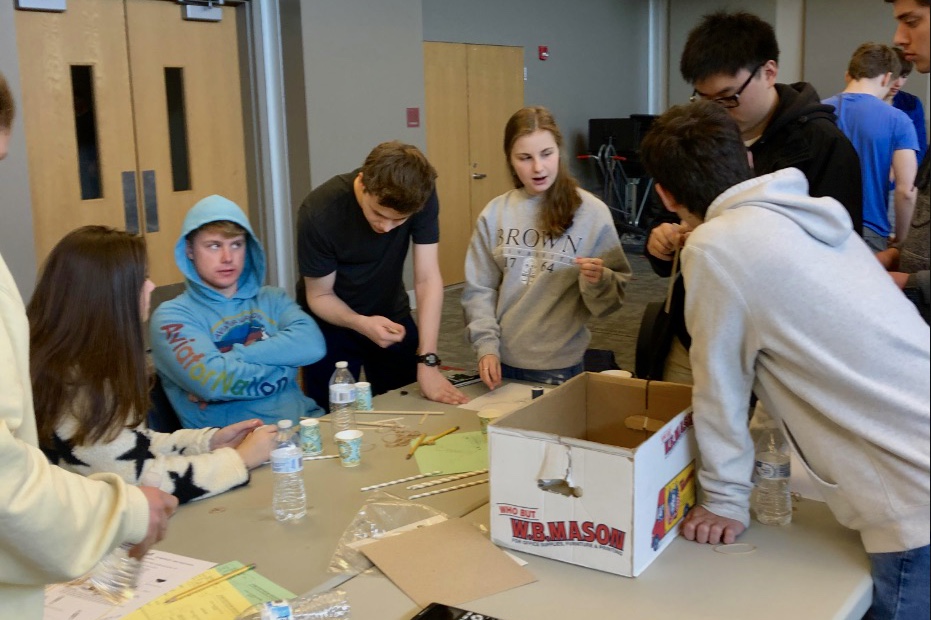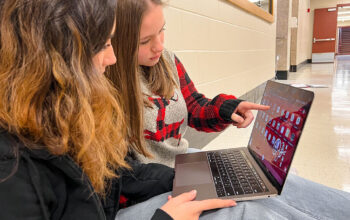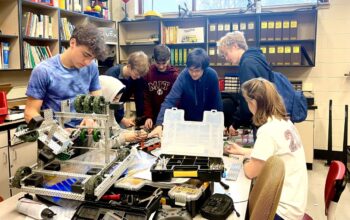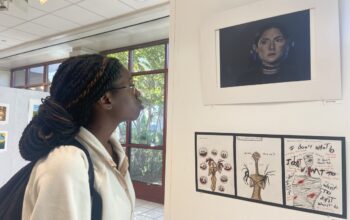Abigail Cushman, Section Editor
@abigailccourant
On Tuesday, March 3 five teams of almost forty students competed against each other at the annual Tests of Engineering Aptitude, Mathematics and Science (TEAMS) competition.

Physics Teacher and TEAMS Coach Paul Reid prepares students for the event. “It is a national competition run by the Technology Student Association (TSA) that pits teams of four to eight students from around the country against one another,” he said.
There are three parts to the competition: one multiple choice section, a design and build section and an essay that must be turned in a day before the competition.
The 90 minute multiple choice section is broken into eight subtopics that students are made aware of before the competition. Each subtopic has ten questions. The team will get that packet and they’ll parcel it out. “Each section is assigned to one person, and then they’ll get back together as a team and help each other with the parts they are having trouble with,” Mr. Reid said.
Every year, the competition is based around a new topic. This year’s topic was “Engineering in the Wild.” The thousand-word essay prompts students to modify an existing zoo within Connecticut state in order to maximize economic, environmental, and societal benefits, as well as the quality of zoo animal life. After a month of collaborative work, each group of students will submit their collective essay to TSA for a grade.

For part three, Design and Build, the students are provided with a selection of materials. “It could be clothespins, pipe cleaners, paperclips, a whole bunch of different things, and they get a task of something that they have to build,” Mr. Reid said.
When competing, students are graded on things like economy, meaning amount of materials used and speed. “All of those things will add to their score for the design and build portion. It’s just like engineering,” Mr. Reid said. “You want to design something that’s strong, light, doesn’t use a lot of materials, and that can do the job quickly.”
Last year, students were prompted to build a robot arm. The purpose behind this was to move a teddy bear from its initial location onto a target at the other end without going over the edge of the table that the teddy bear was sitting on.

Students are also allowed to bring in any reference materials that they can think of that might be helpful. “They can print things out from the internet and use it, they just can’t access the internet when they’re in there. We bring in copies of both the physics and chemistry textbooks, and some dictionaries of science and physics,” Mr. Reid said.
Once the competition is complete, the school receives a series of state awards that depend on students’ performance in each section and overall. “There are national awards also. If we do well enough at the state level, we could go to the national competition,” Mr. Reid said.
The competition used to be done all in one day and students could win a national championship just based on that one day, but now there is a summer competition at the annual TSA convention. “Generally there’s nobody available to go. So we never attend that,” Mr. Reid said.
To recruit participants, at the beginning of the school year Mr. Reid and the other science teachers announce TEAMS to everybody in the physics classes. “Students will take the practice sets to get an idea for what it’s like, and as they get closer we’ll see who’s really interested in participating,” he said.
Junior Elena Unger joined TEAMS her sophomore year. “I thought it sounded really cool and I liked the problem solving aspect of it,” she said. “I think a lot of the time people see STEM related projects as more independent subjects, but I also think collaboration is such a big part of success in science and math. My sister did it too and had a good experience.”

Elena enjoys this team dynamic. When referring to herself and fellow participants as the nerdiest of the nerds,’ she explained how students get assigned to a specific team. “You have a team captain and you guys will do a practice set in school. Our practice set was all about electrical sustainability- doing a lot of tedious calculations in order to see what would be the most beneficial type of lightbulb to use, and other things that are easily applicable to life,” she said.
When Elena and her team received the essay question, they divided the essay work into three sections regarding animal welfare, sustainability, environmental impact, and education reform. Each person was assigned a paragraph and then they compiled it all. “It’s actually nice. When you divide it among the team it’s not bad,” she said.
Senior student and TEAMS member Griffen Dayton participated during his sophomore, junior, and senior years. “In 2018, I was on the sophomore JV team that placed 2nd in the state and 9th in the nation for our division, so we are definitely looking to follow up on that performance as seniors,” he said. “Last year, three of our varsity teams placed top 10 in the state.”
One of Griffen’s favorite memories from last year was when his group wore Hawaiian shirts as a team outfit. “This is just a small example of how we try to make it something fun,” he said.

Team members must work together during each portion of the competition in order to succeed. “The design/build portion of the competition is definitely the more collaborative part of the competition, so even if you hit some bumps in the road when building, everybody is always laughing and having a good time,” Griffen said.
Mr. Reid takes time to familiarize students with the competition format about once a quarter. “Mr. Reid does a great job preparing us for the competition,” Griffen said. “We also had an official practice session where we worked with our group on an old multiple choice test as an in-school field trip about a month ago.”
Students’ knowledge base during the competition relies on information accumulated through years of science education. “AP Physics 1 and AP Physics C have definitely been the most useful for this competition, but there is some chemistry involved and you need to have a strong foundation in mathematics to do well,” Griffen said.
As a senior, this was Griffen’s last high school TEAMS competition. “I am looking forward to competing for one last time with my classmates, and I am looking forward to working together as a team to achieve something we definitely would not have been able to achieve individually,” he said.




